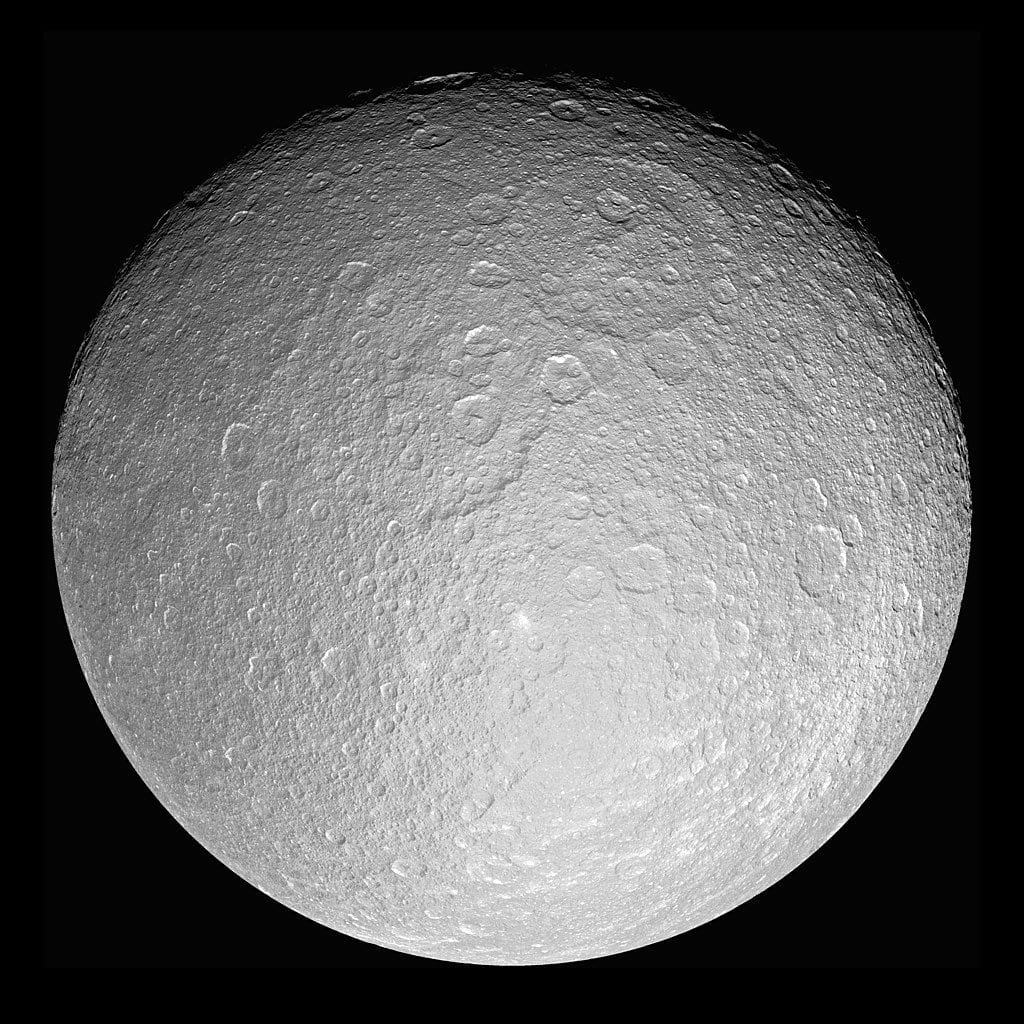The rings and moons of Saturn are interwoven in a complex system. Its 82 moons lie within, between, and beyond its magnificent rings. The rings of Saturn are divided into seven main divisions, with some having structures and sub-divisions in them. These rings are D, C, B, A, F, G, and E, arranged from closest to farthest from the planet. The outer large moons are easy to locate because they lie beyond the tenuous E ring. They are hard to miss as they are some of the biggest and most remarkable members of the Saturnian system. The one we are interested for this post, is the Rhea moon.
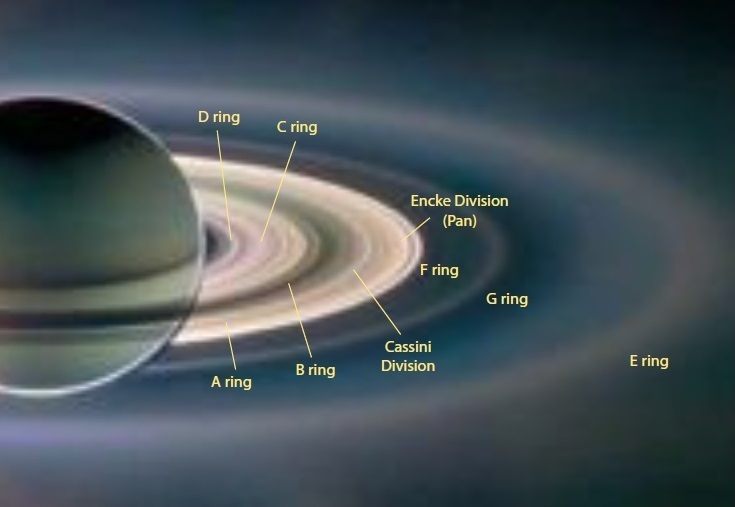
There are four outer large moons: Rhea, Titan, Hyperion, and Iapetus. They are mostly composed of water ice and rock, just like the inner large moons.
The inner large moons orbit Saturn within the thin yet broad E ring. There are also four of them, Mimas, Enceladus, Tethys, and Dione.
The Rhea Moon
Rhea Moon: Facts and Figures
All About the Name
- Pronunciation – /ˈriːə/
- Behind the name – Rheā (A Titaness in Greek mythology)
- Adjective/s – Rhean
- designation/s – Saturn V
Discovery Details
- Discoverer/s – G. D. Cassini
- Discovery date – December 23, 1672
Orbital Characteristics
- Parent planet – Saturn
- Orbital period – 4.518212 days
- Average orbit distance – 527,068 km
- Mean orbit velocity – 30,541.4 km/h
- Eccentricity – 0.001 2583
- Orbital inclination – 0.345° (to Saturn’s equator)
Physical Features
- Dimensions – 1532.4 × 1525.6 × 1524.4 km
- Equatorial radius – 764.3 km
- Equatorial circumference – 4,802.2 km
- Volume – 1,870,166,133 km3
- Moment of inertia factor – 0.3911 ± 0.0045 (disputed)
- Mass – 2,307,089,151,289,080,000,000 kg
- Surface area – 7,340,701.82 km2
- Mean density – 1.236 ± 0.005 g/cm³
- Surface gravity – 0.264 m/s2
- Escape velocity – 2,285 km/h
- Rotation period – 4.518212 days (synchronous)
- Axial tilt – Zero
- Surface temperature – 53K to 99K
- Geometric albedo – 0.949 ± 0.003
- Apparent magnitude – 10
Rhea is an outer large moon of Saturn, lying beyond the E ring. It was discovered in the 17th century. It was named after a Titaness in Greek myth and is also known as Saturn V. We use the adjective Rhean for this moon.
Rhea is more than 1,500 km across, making it Saturn’s second-largest moon after Titan. It is an airless icy body believed to have a rocky core. This dirty snowball shares a lot of similarities with the moons Dione and Tethys in terms of composition, surface temp, and geometric albedo (reflectivity).
Several close approaches to Rhea revealed that the moon’s surface is anything but smooth. What makes this celestial body an exciting subject for exploration is that it has a thin atmosphere and, possibly, a ring system.
Rhea is also unique because its shape is consistent with hydrostatic equilibrium. The dwarf planet Ceres is the only smaller astronomical body to have this feature.
How Did the Moon Rhea Form?
One model that aims to explain the formation of Rhea is the giant-impact hypothesis. It was initially proposed for the formation of the moon Titan, which also gave rise to Rhea’s origin. According to this, giant impacts involving pre-existing moons formed Titan as well as Iapetus and Rhea.
Another theory on its formation involved accretion. In this process, dust and materials are in an orbital motion around a central body. The planets in our solar system also originated this way.
Discovery
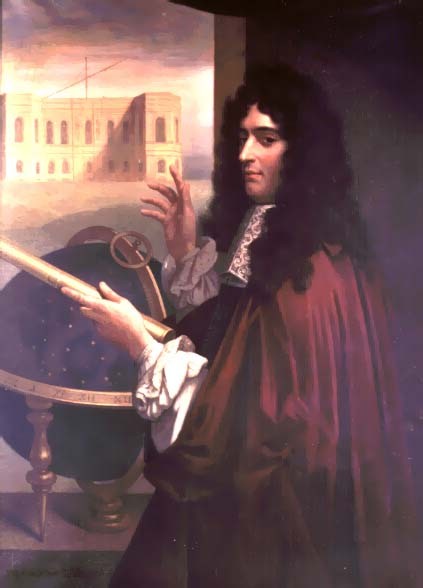 While some of the smaller moons of Saturn were just recently identified because of the Cassini-Huygens mission, Rhea was discovered early on. In fact, it was the third moon ever discovered in the system of Saturn.
While some of the smaller moons of Saturn were just recently identified because of the Cassini-Huygens mission, Rhea was discovered early on. In fact, it was the third moon ever discovered in the system of Saturn.
Italian astronomer, mathematician, and engineer Giovanni Domenico Cassini discovered Rhea on December 23, 1672. About a year earlier, Cassini discovered Iapetus, which is another outer large moon of Saturn.
Did You Know?
Aside from Rhea and Iapetus, Giovanni Cassini also discovered two other moons, Dione and Tethys. Together, he called the four of them Sidera Lodoicea which means “the stars of Louis.” It was an act of honor to King Louis XIV of France.
The Italian-French astronomer is also credited with the discovery of the Cassini Division in Saturn’s rings.
Visits to Rhea
Rhea was one of the earliest discovered moons in the system of Saturn. Unlike other moons that were discovered through spacecraft images, images of Rhea taken from space were taken hundreds of years after its discovery.
In the early 1980s, the twin probes Voyager 1 and 2 provided astronomers a look into the gigantic Rhea. Even though the earlier images of this moon were in lower resolution, they have jumpstarted the journey into this icy world.
A more defined and close-up look on Rhea’s surface was provided by the Cassini probe. The orbiter had done several flybys on the moon. It enabled astronomers to map the moon and make a mosaic of its surface. The position of its craters and its most notable features was seen in views clearer than ever before.
Below are some of Cassini’s most notable approaches/ close targeted flybys to Rhea.
Characteristics
Size
The Rhea moon has a mean radius of 764 km (475 miles), with the dimensions 1532.4 × 1525.6 × 1524.4 km. It ranks as the ninth-largest moon in the Solar System.
It is 3.4 times smaller than Titan, the biggest moon of Saturn, and 2.3 times smaller than our very own satellite, the Earth’s Moon.
Composition
Rhea’s composition is a homogeneous mixture of water ice and rock. Specifically, it is comprised of about 75% icy material and only 25% rock. This moon is in hydrostatic equilibrium.
In theory, the process of radioactive decay may be able to produce enough heat for Rhea to turn its water ice into an internal ocean of liquid water.
Density
In spite of its large size, Rhea has a low density which is approximately 1.236 g/cm3. It is only the tenth-most massive moon in the solar system.
Temperature
The sun-facing area of Rhea has a temperature of 99 K (−174 °C). Its far side, on the other hand, is much colder. The temperature in this area varies accordingly and ranges from 73 K (−200 °C) to 53 K (−220 °C).
Geometric Albedo
The geometric albedo of a body has something to do with its reflectivity. Rhea’s high reflectivity rate of about 95% indicates that this astronomical object is mostly made up of water ice.
Orbit
Rhea orbits Saturn at a distance of approx. 527,000 km. It completes a full circle around the planet by about 4.5 Earth days or roughly 108 hours.
Its rotation period is the same as its orbital period, a phenomenon called synchronous rotation. Because of this, it is tidally locked to Saturn. Only one side of Rhea faces the planet.
Atmosphere
Every planet in the solar system has an atmosphere. However, not all moons do. Only the largest moons have atmospheres but they are also very thin.
Several icy moons in the solar system may have complex chemistry caused by oxygen and carbon dioxide formation. Rhea is one of them. The Cassini probe was able to capture the molecules of this oxygen atmosphere— a feat that was previously done only on our planet.
Rhea’s exosphere was discovered in 2010. This tenuous structure is made up of oxygen and carbon dioxide. The atmosphere at Rhea’s surface is so thin that it is roughly 5 trillion times less dense than the Earth’s.
The source of oxygen in Rhea’s atmosphere has been determined but not the origin of the carbon dioxide. Oxygen is produced when particles from Saturn’s magnetic field get trapped in the magnetic field of Rhea. A chemical reaction happens which then decomposes the water ice surface of the moon. Oxygen is released as a result.
In the exosphere of Rhea, surface density can become much greater than that of our Moon or even the planet Mercury due to surface decomposition.
Possible Ring/s
The existence of rings around a natural satellite is something that is yet unheard of. This may be about to change. The Cassini spacecraft found evidence of debris orbiting around the moon Rhea in 2008.
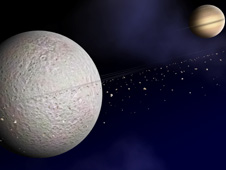
Cassini saw the presence of some particles around the moon. This was something common among Saturn’s moons as dust rain regularly hit objects in space. But what was uncommon was the difference that the Cassini instruments detected on its side.
It seemed like there was something that shielded the Cassini orbiter from the rain when it was on either side of the moon, as the detection of electrons was much lower in those areas. This flyby of 2008 made astronomers infer that Rhea must have a ring system of its own, just like its parent planet.
Aside from a dust cloud which most likely expands thousands of kms from Rhea’s center, it probably has at least a ring and a debris disk surrounding it. The objects in these structures are most likely as small as pebbles and as big as boulders. The said debris disk is estimated to be some thousands of miles across.
If confirmed, Rhea would be the first-ever moon known to have rings.
Did You Know?
The rings of planet Uranus were discovered in a similar way as the possible ring/s of Rhea.
In 1977, NASA’s Kuiper Airborne Observatory detected a change when a star passed behind the ice giant. The star blinked on and off, which made scientists conclude that there may be a structure near Uranus that seemed to block the light from the star as seen here on Earth.
What Does the Moon Rhea Look Like?
Rhea is a round moon with lots of craters. The cratered plains of this moon are estimated to be roughly four billion years old. It shares many similar surface characteristics with the moon Dione.
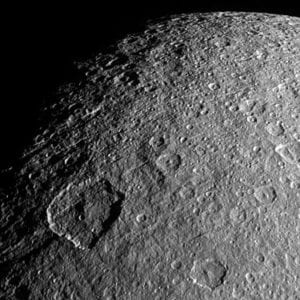
There is a faint “line” along the equator of Rhea which may be material from its possible ring/s. Aside from that, there are other features on its surface that look like “wispy” lines. These linear features extend hundreds of kms across the surface of the moon.
The Cassini spacecraft was able to take a lot of images of Rhea’s surface. All of them have one thing in common, that the moon is scarred with craters all over its ancient body. Below are some of them. (Courtesy NASA/JPL/Space Science Institute).
As Seen in Voyager Images
Astronomers noticed that Rhea has two distinct regions, as seen in the images sent by the Voyager probes. This may be a sign of some resurfacing event that happened on the moon in the distant past.
The two areas show differences in crater sizes and density. One region is populated with larger craters that are more than 40 km (25 miles) in diameter while the other area type has craters measuring less than 40 km across. The smaller craters are found near the moon’s poles and its equatorial regions.
The Leading and Trailing Hemispheres
 Rhea’s leading hemisphere is, overall, bright. This area is littered with craters that are comparable to Jupiter’s second-largest moon, Callisto. Its trailing hemisphere is a darker area with some craters visible.
Rhea’s leading hemisphere is, overall, bright. This area is littered with craters that are comparable to Jupiter’s second-largest moon, Callisto. Its trailing hemisphere is a darker area with some craters visible.
Noticeable swaths or strips of bright material can be seen on Rhea’s trailing hemisphere. Images sent by the Cassini probe revealed that the “wispy” structures are actually fractures or chasmata from Rhean canyons. It somehow formed some “ice cliffs,” thus the bright appearance. This type of deep and elongated depression is an indication that the moon had probably undergone some tectonic activity in the past.
Geological Features
The geological features of Rhea are of different kinds and sizes. They were given names inspired by mythologies around the world. Five kinds of features can be seen on the moon Rhea.
Types of Geological Features on Rhea’s Surface
Craters – Circular depressions that are a result of impacts
Catenae – Crater chains
Chasmata – Elongated, deep, and steep depressions
Fossae – Long but narrow depressions
Lineae – Long markings on the surface
A lot of Rhean craters have been given names since they are the most common feature of the moon. Nearly 130 of its craters have been named as of 2017.
Two of the most prominent impact craters of Rhea are called Tirawa and Inktomi.
Tirawa
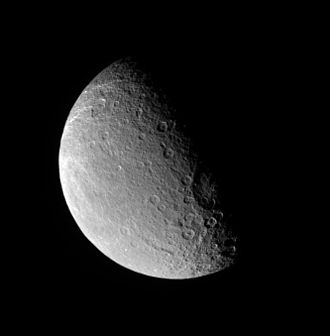
Tirawa is one of the largest impact craters of Rhea. It is about 5 km deep and measures 360 km across. This crater lies on the moon’s nightside or the part that is facing away from the ringed planet. It can be partly seen straddling the day/night terminator in the above photo.
Inktomi
Inktomi is also called “the Splat.” Its permanent name was based on the spider-god of the Lakota. This surface feature can be easily found because of its rayed appearance.
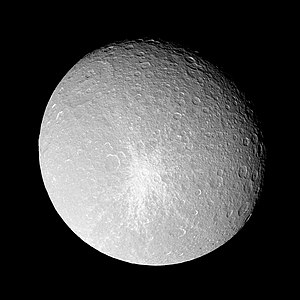
This rayed impact crater measures 47.2 km (29.3 miles) across. It is approx. 8 to 280 million years old, the youngest of Rhea’s surface features. Inktomi is in the moon’s southern hemisphere.
In Comparison to Dione and Tethys
Rhea is more cratered than its sister moons Dione and Tethys. It may be because of two reasons. One could be because it received more bombardment than the other two. The other factor involves distance.
Rhea is farther from Saturn than the two inner large moons. The planet’s tidal variations affect Dione and Tethys more since they are closer to the planet. This influence leads to internal heating which somewhat erases the craters of the inner moons.
The “erasing” of these surface depressions happens when heated water ice becomes liquid water. The liquid then pools in the depressions where it freezes again. That way, the craters, and other depressions are filled which smoothens some areas of Dione and Tethys.
Behind the Name
The major moons of Saturn were given the Roman numeral designations based on their distance from the planet.
Saturn V was given to Rhea because it is the fifth major moon from the ringed planet. The closest major moon is Mimas which is known as Saturn I and the furthest is Iapetus, also known as Saturn VIII.
Major Moons of Saturn and Their Designations
- Mimas – Saturn I
- Enceladus – Saturn II
- Tethys – Saturn III
- Dione – Saturn IV
- Rhea – Saturn V
- Titan – Saturn VI
- Hyperion – Saturn VII
- Iapetus – Saturn VIII
The permanent name, Rhea, was awarded to this moon in 1847. It was based on a character in Greek myth, consistent with how the other moons of Saturn were named. This convention was suggested by John Herschel who was the son of another great astronomer William Herschel.
Rhea in Greek Mythology
Titaness Rhea (also Rheia) was the sister and wife of Cronus (also Kronos). They were the parents of the six principal gods of Olympus: Demeter, Hades, Hera, Hestia, Poseidon, and Zeus. Hence, Rhea is also called the “mother of the gods.” A close association with her being a mother figure is Cybele.
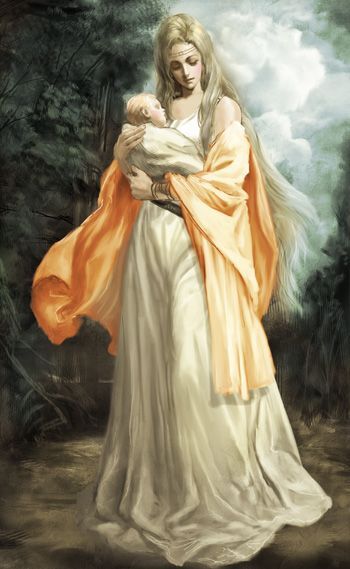
Rhea’s mother was Gaia, goddess of the earth, and Uranus the sky god. Cronus overthrew his father and took over the throne. His rule would not last forever though. A prophecy was told that the same fate will fall upon him and one of his children will overpower him.
Cronus devised all ways to avoid this from happening that he swallowed his children the moment after their birth. Seeing this, Rhea, together with Gaia and Uranus, tried to save her youngest by giving birth to him secretly in Crete. The baby was named Zeus.
Rhea was able to conceal the birth of Zeus by giving a stone wrapped in baby clothes to Cronus, which he unknowingly swallowed. The young god, Zeus, was protected and guarded by some attendants in a cave.
The prophecy turned out to be true when Zeus grew up and at last faced his father. He rescued his siblings by forcing the Titan Cronus to disgorge his brothers and sisters. A battle called the Titanomachy ensued which left the gods and goddesses victorious.
The era of the Titans ended as the new rulers, led by Zeus, took their seats atop Mount Olympus.
Statistical Sources:
- https://en.wikipedia.org/wiki/Rhea_(moon)
- https://solarsystem.nasa.gov/moons/saturn-moons/rhea/in-depth/
- https://solarsystem.nasa.gov/moons/saturn-moons/rhea/by-the-numbers/
- https://www.nasa.gov/mission_pages/cassini/media/rhea20080306.html
- https://en.wikipedia.org/wiki/Rhea_(mythology)
Image Sources:
- Saturn rings: https://usuaris.tinet.cat/klunn/ast-saturn-rings.html
- Rhea moon; what it looks like; leading and trailing hemispheres; “wispy lines: https://en.wikipedia.org/wiki/Rhea_(moon)
- G.D. Cassini: https://en.wikipedia.org/wiki/Giovanni_Domenico_Cassini
- Rhea Rings (artist concept): https://www.nasa.gov/mission_pages/cassini/media/rhea20080306.html
- Other surface features (series of images): https://solarviews.com/eng/rhea.htm
- Tirawa crater: https://en.wikipedia.org/wiki/Tirawa_(crater)
- Inktomi crater: https://en.wikipedia.org/wiki/Inktomi_(crater)
- Rhea (Titaness): https://greekmythology.wikia.org/wiki/Rhea?file=R-H-E-A.jpg
